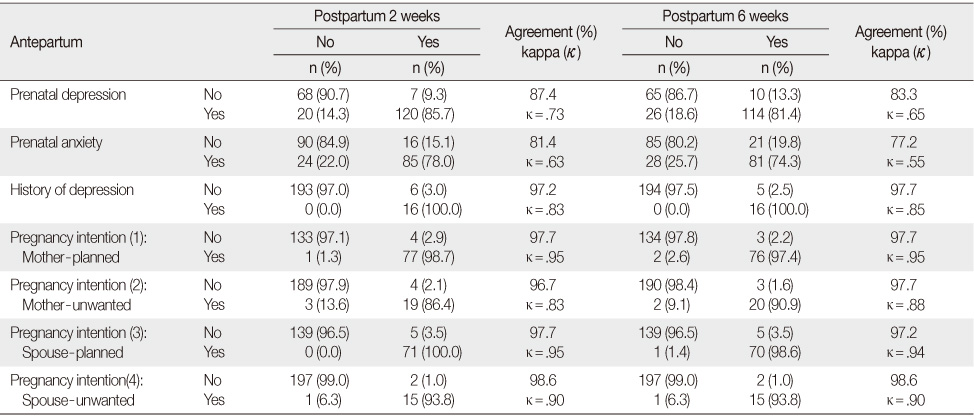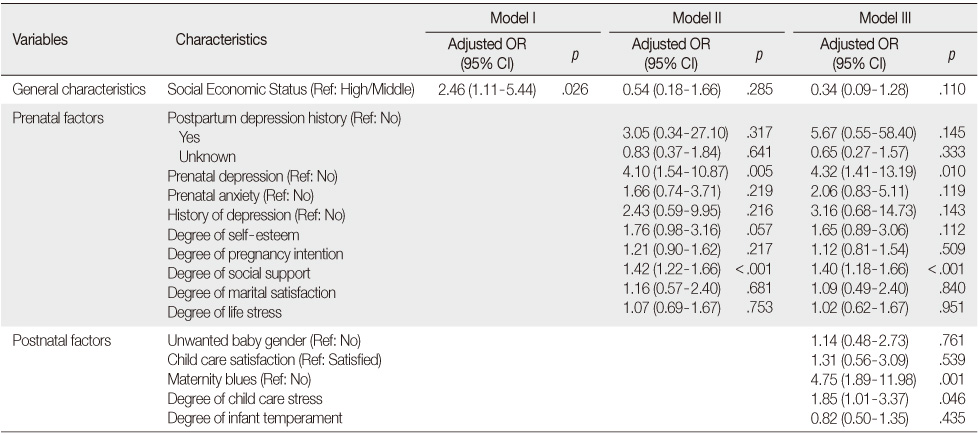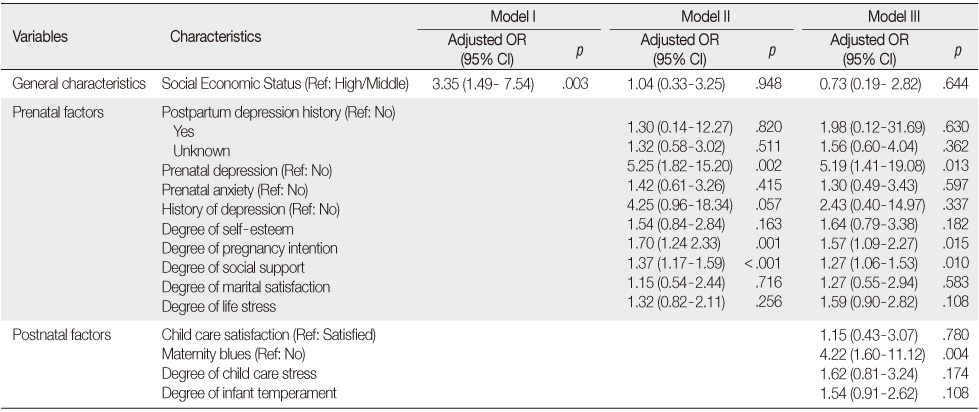Articles
- Page Path
- HOME > J Korean Acad Nurs > Volume 43(2); 2013 > Article
-
Original Article
- Predictors of Postpartum Depression: Prospective Cohort Study
- Ji Hyang Youn, Ihn Sook Jeong
-
Journal of Korean Academy of Nursing 2013;43(2):225-235.
DOI: https://doi.org/10.4040/jkan.2013.43.2.225
Published online: April 30, 2013
College of Nursing, Pusan National University, Yangsan, Korea.
- Address reprint requests to: Jeong, Ihn Sook. College of Nursing, Pusan National University, Beomoe-ri, Mulgeum-eup, Yangsan 626-870, Gyungnam, Korea. Tel: +82-51-510-8342, Fax: +82-51-510-8308, jeongis@pusan.ac.kr
© 2013 Korean Society of Nursing Science
Abstract
-
Purpose
- This prospective cohort study was done to investigate recall bias to antepartum variables measured at postpartum periods and predictors of postpartum depression.
-
Methods
- Participants were 215 women who answered a self-administered questionnaire which included demographics, Postpartum Depression Predictors Inventory-Revised and Korean version of Edinburgh Postpartum Depression Scale at antepartum 36-40 weeks and postpartum 2 weeks and 6 weeks. Data were analyzed using kappa, and hierarchical multiple logistic regression.
-
Results
- Agreement between antepartum variables at both antepartum and two postpartum periods was relatively high (κ=.55-.95). Postpartum depression rates were 36.3% and 36.7% at two follow-up points. In hierarchical multiple logistic regression analysis, prenatal depression (OR=4.32, 95% CI: 1.41-13.19; OR=5.19, 95% CI: 1.41-19.08), social support (OR=1.40, 95% CI: 1.18-1.66; OR=1.27, 95% CI: 1.06-1.53) and maternity blues (OR=4.75, 95% CI: 1.89-11.98; OR=4.22, 95% CI: 1.60-11.12) were commonly associated with postpartum depression at two follow-up points. Child care stress (OR=1.85, 95% CI: 1.01-3.37) was only associated with postpartum depression at 2 weeks postpartum and pregnancy intendedness (OR=1.57, 95% CI: 1.09-2.27) was only associated with postpartum depression at 6 weeks postpartum.
-
Conclusions
- The results indicate a need to apply nursing interventions such as prenatal education and counseling with families from antenatal period.
This manuscript is based on a part of the first author's master's thesis from Pusan National University.
- 1. Ahn OS, Oh WO. Relationship among postpartum depression, parenting stress and self-esteem in mothers during puerperium. J Korean Soc Matern Child Health. 2006;10(1):58–68.
- 2. American Psychiatric Association. Diagnostic and statistical manual of mental disorders, fourth edition, text revision (DSM-IV-TR®). 2000;Washington, DC, Author.
- 3. Avan B, Richter LM, Ramchandani PG, Norris SA, Stein A. Maternal postnatal depression and children's growth and behaviour during the early years of life: Exploring the interaction between physical and mental health. Arch Dis Child. 2010;95(9):690–695. http://dx.doi.org/10.1136/adc.2009.164848.ArticlePubMed
- 4. Bae JI. Construction of a postpartum depression model. J Korean Acad Psychiatr Ment Health Nurs. 2002;11(4):572–587.ArticlePDF
- 5. Beck CT. Predictors of postpartum depression: An update. Nurs Res. 2001;50(5):275–285.PubMed
- 6. Beck CT. Revision of the postpartum depression predictors inventory. J Obstet Gynecol Neonatal Nurs. 2002;31(4):394–402.ArticlePubMed
- 7. Beck CT, Records K, Rice M. Further development of the postpartum depression predictors inventory-revised. J Obstet Gynecol Neonatal Nurs. 2006;35(6):735–745. http://dx.doi.org/10.1111/j.1552-6909.2006.00094.x.ArticlePubMed
- 8. Centers for Disease Control and Prevention. Prevalence of self-reported postpartum depressive symptoms-17 states, 2004-2005. MMWR Morb Mortal Wkly Rep. 2008;57(14):361–366.ArticlePubMed
- 9. Chaudron LH, Pies RW. The relationship between postpartum psychosis and bipolar disorder: A review. J Clin Psychiatry. 2003;64(11):1284–1292.ArticlePubMed
- 10. Corwin EJ, Kohen R, Jarrett M, Stafford B. The heritability of postpartum depression. Biol Res Nurs. 2010;12(1):73–83. http://dx.doi.org/10.1177/1099800410362112.ArticlePubMedPDF
- 11. Cox JL, Holden JM, Sagovsky R. Detection of postnatal depression. Development of the 10-item edinburgh postnatal depression scale. Br J Psychiatry. 1987;150:782–786.ArticlePubMed
- 12. Gjerdingen DK, Froberg DG, Chaloner KM, McGovern PM. Changes in women's physical health during the first postpartum year. Arch Fam Med. 1993;2(3):277–283.ArticlePubMed
- 13. Gupta R, Kar BR. Attention and memory biases as stable abnormalities among currently depressed and currently remitted individuals with unipolar depression. Front Psychiatry. 2012;3:99. http://dx.doi.org/10.3389/fpsyt.2012.00099.PubMedPMC
- 14. Han KW, Kim MJ, Park JM. The edinburgh postnatal depression scale, Korean version: Reliability and validity. J Korean Soc Biol Ther Psychiatry. 2004;10(2):201–207.
- 15. Jang EJ. Psychosocial and obstetric factors associated with postpartum depressive symptoms. 2008;Gyeong-ju, Dongguk University. Unpublished master's thesis.
- 16. Josefsson A, Berg G, Nordin C, Sydsjö G. Prevalence of depressive symptoms in late pregnancy and postpartum. Acta Obstet Gynecol Scand. 2001;80(3):251–255.ArticlePubMedPDF
- 17. Jung MH, Kim JI. A study on the relationship among prenatal emotional status, preparation for delivery, postpartum social support and postpartum blues. Korean J Women Health Nurs. 2005;11(1):38–45.ArticlePDF
- 18. Kim JW, Kim JH, Kim BJ. Psychosocial and obstetric factors associated with postpartum depressive symptoms. J Korean Neuropsychiatr Assoc. 2005;44(2):213–220.
- 19. Kim MW, Yang HS, Kim JR. A study on agreements among screening tests and related factors with postpartum depression. Korean J Obstet Gynecol. 2009;52(11):1133–1143.
- 20. Kim SO. Postpartum depression and maternal identity of the high risk women. 2009;Gangneung, Kwandong University. Unpublished master's thesis.
- 21. Kim YK, Hur JW, Kim KH, Oh KS, Shin YC. Clinical application of Korean version of edinburgh postnatal depression scale. J Korean Neuropsychiatr Assoc. 2008;47(1):36–44.
- 22. Kwon M, Kim H, Kim N, Jang J. Postpartum depression and maternal role confidence, parenting stress, and infant temperament in mothers of young infants. J Korean Acad Child Health Nurs. 2006;12(3):314–321.
- 23. Meadows SO, McLanahan SS, Brooks-Gunn J. Parental depression and anxiety and early childhood behavior problems across family types. J Marriage Fam. 2007;69(5):1162–1177.Article
- 24. Miyake Y, Tanaka K, Sasaki S, Hirota Y. Employment, income, and education and risk of postpartum depression: The Osaka maternal and child health study. J Affect Disord. 2011;130(1-2):133–137. http://dx.doi.org/10.1016/j.jad.2010.10.024.ArticlePubMed
- 25. Moses-Kolko EL, Berga SL, Kalro B, Sit DK, Wisner KL. Transdermal estradiol for postpartum depression: A promising treatment option. Clin Obstet Gynecol. 2009;52(3):516–529. http://dx.doi.org/10.1097/GRF.0b013e3181b5a395.ArticlePubMedPMC
- 26. Oppo A, Mauri M, Ramacciotti D, Camilleri V, Banti S, Borri C, et al. Risk factors for postpartum depression: The role of the postpartum depression predictors inventory-revised (PDPI-R). Results from the perinatal depression-research & screening unit (PNDReScU) study. Arch Womens Ment Health. 2009;12(4):239–249. http://dx.doi.org/10.1007/s00737-009-0071-8.ArticlePubMedPDF
- 27. Paulson JF, Bazemore SD. Prenatal and postpartum depression in fathers and its association with maternal depression: A meta-analysis. JAMA. 2010;303(19):1961–1969. http://dx.doi.org/10.1001/jama.2010.605.ArticlePubMed
- 28. Rubertsson C, Wickberg B, Gustavsson P, Rådestad I. Depressivesymptoms in early pregnancy, two months and one year postpartum-prevalence and psychosocial risk factors in a national Swedish sample. Arch Womens Ment Health. 2005;8(2):97–104. http://dx.doi.org/10.1007/s00737-005-0078-8.ArticlePubMedPDF
- 29. Ryu JM. Postpartum depression and its predictors at 1 to 6 months postpartum in Korea. 2008;Seoul, Hanyang University. Unpublished master's thesis.
- 30. Viera AJ, Garrett JM. Understanding interobserver agreement: The kappa statistic. Fam Med. 2005;37(5):360–363.PubMed
- 31. Yeo JH. Postpartum depression and its predictors at six months postpartum. Korean J Women Health Nurs. 2006;12(4):355–362.ArticlePDF
- 32. Youn JH, Jeong IS. Predictive validity of the postpartum depression predictors inventory-revised. Asian Nurs Res. 2011;5(4):210–215. http://dx.doi.org/10.1016/j.anr.2011.11.003.Article
REFERENCES
Figure & Data
REFERENCES
Citations

- Analysis of the Association of Dietary Patterns With Depression in Pregnant Women using Big Data – Mediating Effect of Blood Heavy Metal Concentration
Seowoo Jung, Minji Kim, Jungsil Lee, Jieun Min, Hyesook Kim, Eun-Kyung Lee, Eunhee Ha
Journal of Health Informatics and Statistics.2025; 50(2): 181. CrossRef - Preventive Effects of Prenatal Folic Acid on Postpartum Depression
Xueqin Feng, Chunxia Wang, Fuling Wang, Xiaoyun Zhang, Hua Shu, Hui Chen, Liting Duan, Yuxi Wei, Jishui Wang, Dongmei Man, Fanyong Zhang
Topics in Clinical Nutrition.2024; 39(1): 46. CrossRef - Is social support associated with postpartum depression, anxiety and perceived stress among Korean women within the first year postpartum?
Mi-Sun Lee, Jung Jae Lee, Soyeon Park, Seongju Kim, Hooyeon Lee
Journal of Psychosomatic Obstetrics & Gynecology.2023;[Epub] CrossRef - Postpartum Blues in Fathers: Prevalence, Associated Factors, and Impact on Father-to-Infant Bond
Claire Baldy, Eloi Piffault, Margaux Chabbert Chopin, Jaqueline Wendland
International Journal of Environmental Research and Public Health.2023; 20(10): 5899. CrossRef - Effectiveness of the Korean Medicine-Based Postnatal Healthcare Program: A Retrospective Observational Study
Joohee Seo, Doeun Lee, Hansong Park, Inae Youn, Jungtae Leem, Minjung Park
Perspectives on Integrative Medicine.2023; 2(2): 117. CrossRef - Factors influencing prenatal and postpartum depression in Korea: a prospective cohort study
Hyeji Yoo, Sukhee Ahn, Seyeon Park, Jisoon Kim, Jiwon Oh, Minseon Koh
Korean Journal of Women Health Nursing.2021; 27(4): 326. CrossRef - Edinburgh Postnatal Depression Scale used in South Korea
Rora Oh, Young-Ho Khang, Yu-Mi Kim
Journal of the Korean Medical Association.2021; 64(10): 699. CrossRef - Depression and stress in Korean parents: A cohort study
Hyeji Yoo, Sukhee Ahn, Jiwon Oh, Seyeon Park, Jisoon Kim, Minseon Koh
Applied Nursing Research.2021; 62: 151519. CrossRef - Association between dietary patterns during the third trimester and the risk of postpartum depression in China
Lujia Cao, Yuyan Liu, Xuan Liang, Yuzhi Zheng, Wen Li, Jing Yan, Guowei Huang
Journal of Affective Disorders.2020; 264: 370. CrossRef - Relationships of Perfectionism Dimensions with Postpartum Depression
Suyoung Choi, Mi Yeul Hyun
Journal of Korean Academy of Psychiatric and Mental Health Nursing.2019; 28(1): 1. CrossRef - Postpartum depression screening: are we doing a competent job?
Sathyanarayan Sudhanthar, Zile-e-huma Sheikh, Kripa Thakur
BMJ Open Quality.2019; 8(4): e000616. CrossRef - Pregnant Women's Antenatal Depression and Influencing Factors
Minseon Koh, Sukhee Ahn, Jisoon Kim, Seyeon Park, Jiwon Oh
Korean Journal of Women Health Nursing.2019; 25(1): 112. CrossRef - Antenatal Depressive Symptoms and Associated Risk Factors among Pregnant Women
Seung Jae Baek, Ji-ae Yun, Ji ae Nam, Eun Young Seo, Seo Young Kwon, Chang Hwa Lee, Kyeong-Sook Choi
Journal of Korean Neuropsychiatric Association.2019; 58(4): 346. CrossRef - The Psychometric Validation of the EPDS-K Among Korean Women: Does It Only Measure Depressive Symptoms?
Young-sun Rhee, Jeong-hwan Park, Hee-Jung Cha, Kye-ha Kim
Perspectives in Psychiatric Care.2018; 54(2): 115. CrossRef - Trajectories of First-Time Mothers’ Depressive Symptoms During Six Years Postpartum and Behavioral Problems of Their First Child at Age 6 Years
Yeon Ha Kim
Korean Journal of Child Studies.2018; 39(6): 101. CrossRef - Association between Duration of Folic Acid Supplementation during Pregnancy and Risk of Postpartum Depression
Jing Yan, Yuyan Liu, Lujia Cao, Yuzhi Zheng, Wen Li, Guowei Huang
Nutrients.2017; 9(11): 1206. CrossRef - Factors Influencing Maternal Depression: Secondary Data Analysis
Chul-Gyu Kim, Mi-Young Choi
Korean Journal of Adult Nursing.2016; 28(3): 288. CrossRef - Status and Influencing factors of health behavior in pregnant women in Yanbian area
Hai-Lian Zhang, Chun-Yu Li, Hyun-Li Kim
Journal of the Korea Academia-Industrial cooperation Society.2015; 16(11): 7863. CrossRef - Effects of Foot-Reflexology Massage on Fatigue, Stress and Postpartum Depression in Postpartum Women
Mi Son Choi, Eun Ja Lee
Journal of Korean Academy of Nursing.2015; 45(4): 587. CrossRef - Prevalence of and Risk Factors for Depressive Symptoms in Korean Women throughout Pregnancy and in Postpartum Period
Jeong-hwan Park, Wilfried Karmaus, Hongmei Zhang
Asian Nursing Research.2015; 9(3): 219. CrossRef - Effects of Self Efficacy, Body Image and Family Support on Postpartum Depression in Early Postpartum Mothers
Ji-Won Lee, Yong-Sook Eo, Eun-Hye Moon
Journal of the Korea Academia-Industrial cooperation Society.2015; 16(6): 4011. CrossRef - The Trajectories and Predictors of Maternal Post Natal Depressive Symptoms in a High Risk Group, Based on Latent Growth Modeling
Wanjeong Lee, Gyunhee Kim
Korean Journal of Child Studies.2015; 36(3): 77. CrossRef - Factors associated with Postpartum Depression and Its Influence on Maternal Identity
Yoen Yi Jung, Hae Won Kim
Korean Journal of Women Health Nursing.2014; 20(1): 29. CrossRef - Predictors of Early Postpartum Depression in Mothers of Preterm Infants in Neonatal Intensive Care Units.
Jae Young Lee, Hyeon Ok Ju
Child Health Nursing Research.2014; 20(2): 87. CrossRef - Prevalence and risk factors of postpartum depression in a population-based sample of women in Tangxia Community, Guangzhou
Ai-Wen Deng, Ri-Bo Xiong, Ting-Ting Jiang, Ying-Ping Luo, Wang-Zhong Chen
Asian Pacific Journal of Tropical Medicine.2014; 7(3): 244. CrossRef - Status of Antepartum Depression and Its Influencing Factors in Pregnant Women
Eun-Joo Lee, Jeong-Sook Park
Journal of the Korea Academia-Industrial cooperation Society.2013; 14(8): 3897. CrossRef
Homogeneity of General Characteristics of Participants Dropped out and Completed (N=359)
†Fisher's exact test.
Agreement of Antepartum Variables Measured at Antepartum and Postpartum Periods (N=215)
Distribution of Postpartum Depression Scores at Each Time Point (N=215)
K-EPDS=Korean-Edinburgh Postnatal Depression Scale.
*M±SD at Postpartum 2 weeks: 8.4±6.8; †M±SD at Postpartum 6 weeks: 9.0±8.2; ‡McNemar test.
Predictors of Postpartum Depression at 2 Weeks after Giving a Birth by Hierarchical Multiple Logistic Regression Analysis (N=215)
Predictors of Postpartum Depression at 6 Weeks after Giving a Birth by Hierarchical Multiple Logistic Regression Analysis (N=215)
†Fisher's exact test.
K-EPDS=Korean-Edinburgh Postnatal Depression Scale. *M±SD at Postpartum 2 weeks: 8.4±6.8; †M±SD at Postpartum 6 weeks: 9.0±8.2; ‡McNemar test.
 KSNS
KSNS
 E-SUBMISSION
E-SUBMISSION





 Cite
Cite

